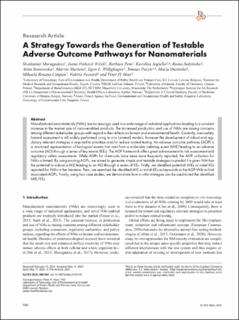| dc.contributor.author | Murugadoss, Sivakumar | |
| dc.contributor.author | Vrcek, Ivana Vinkovic | |
| dc.contributor.author | Pem, Barbara | |
| dc.contributor.author | Jagiello, Karolina | |
| dc.contributor.author | Judzinska, Beata | |
| dc.contributor.author | Sosnowska, Anita | |
| dc.contributor.author | Martens, Marvin | |
| dc.contributor.author | Willighagen, Egon L. | |
| dc.contributor.author | Puzyn, Tomasz | |
| dc.contributor.author | Dusinska, Maria | |
| dc.contributor.author | Cimpan, Mihaela-Roxana | |
| dc.contributor.author | Fessard, Valérie | |
| dc.contributor.author | Hoet, Peter H. | |
| dc.date.accessioned | 2021-11-29T11:10:45Z | |
| dc.date.available | 2021-11-29T11:10:45Z | |
| dc.date.created | 2021-05-25T13:05:10Z | |
| dc.date.issued | 2021 | |
| dc.identifier.issn | 1868-596X | |
| dc.identifier.uri | https://hdl.handle.net/11250/2831879 | |
| dc.description.abstract | Manufactured nanomaterials (NMs) are increasingly used in a wide range of industrial applications leading to a constant increase in the market size of nano-enabled products. The increased production and use of NMs are constantly raising concerns among different stakeholder groups with regard to their effects on human and environmental health. Currently, nanosafety hazard assessment is still widely performed using in vivo (animal) models, however the development of robust and regulatory relevant strategies is required to prioritize and/or reduce animal testing. Adverse outcome pathways (AOPs) are a structured representation of biological events that start from a molecular initiating event (MIE) leading to an adverse outcome (AO) through a series of key events (KEs). The AOP framework offers great advancement to risk assessment and regulatory safety assessments. While AOPs for chemicals have been more frequently reported, AOPs collection for NMs is narrow. By using existing AOPs, we aimed to generate simple and testable strategies to predict if a given NM has the potential to induce a MIE leading to an AO through a series of KEs. Firstly, we identified potential MIEs or initial KEs reported for NMs in the literature. Then, we searched the identified MIE or initial KEs as keywords in the AOP-Wiki to find associated AOPs. Finally, using two case studies, we demonstrated here how in vitro strategies can be used for testing the identified MIE/KEs. | en_US |
| dc.language.iso | eng | en_US |
| dc.publisher | Springer | en_US |
| dc.rights | Navngivelse 4.0 Internasjonal | * |
| dc.rights.uri | http://creativecommons.org/licenses/by/4.0/deed.no | * |
| dc.title | A strategy towards the generation of testable adverse outcome pathways for nanomaterials | en_US |
| dc.type | Journal article | en_US |
| dc.type | Peer reviewed | en_US |
| dc.description.version | publishedVersion | en_US |
| dc.rights.holder | Copyright 2021 The Authors | en_US |
| cristin.ispublished | false | |
| cristin.fulltext | original | |
| cristin.qualitycode | 1 | |
| dc.identifier.doi | 10.14573/altex.2102191 | |
| dc.identifier.cristin | 1911703 | |
| dc.source.journal | Altex | en_US |
| dc.source.pagenumber | 580-594 | en_US |
| dc.relation.project | EC/H2020/814425 | en_US |
| dc.relation.project | NILU - Norsk institutt for luftforskning: 119011 | en_US |
| dc.identifier.citation | Altex. 2021, 38 (4), 580-594 | en_US |
| dc.source.volume | 38 | en_US |
| dc.source.issue | 4 | en_US |

